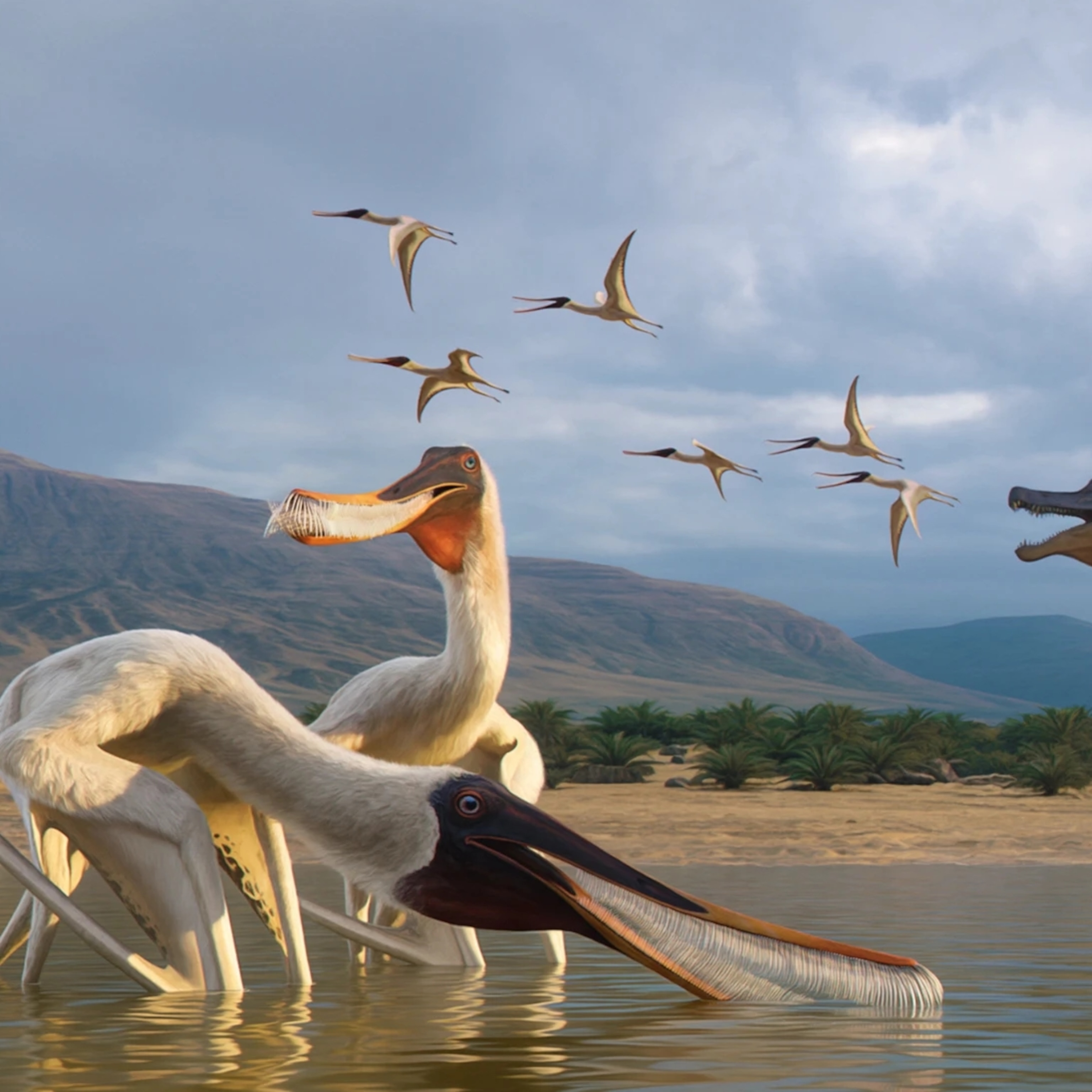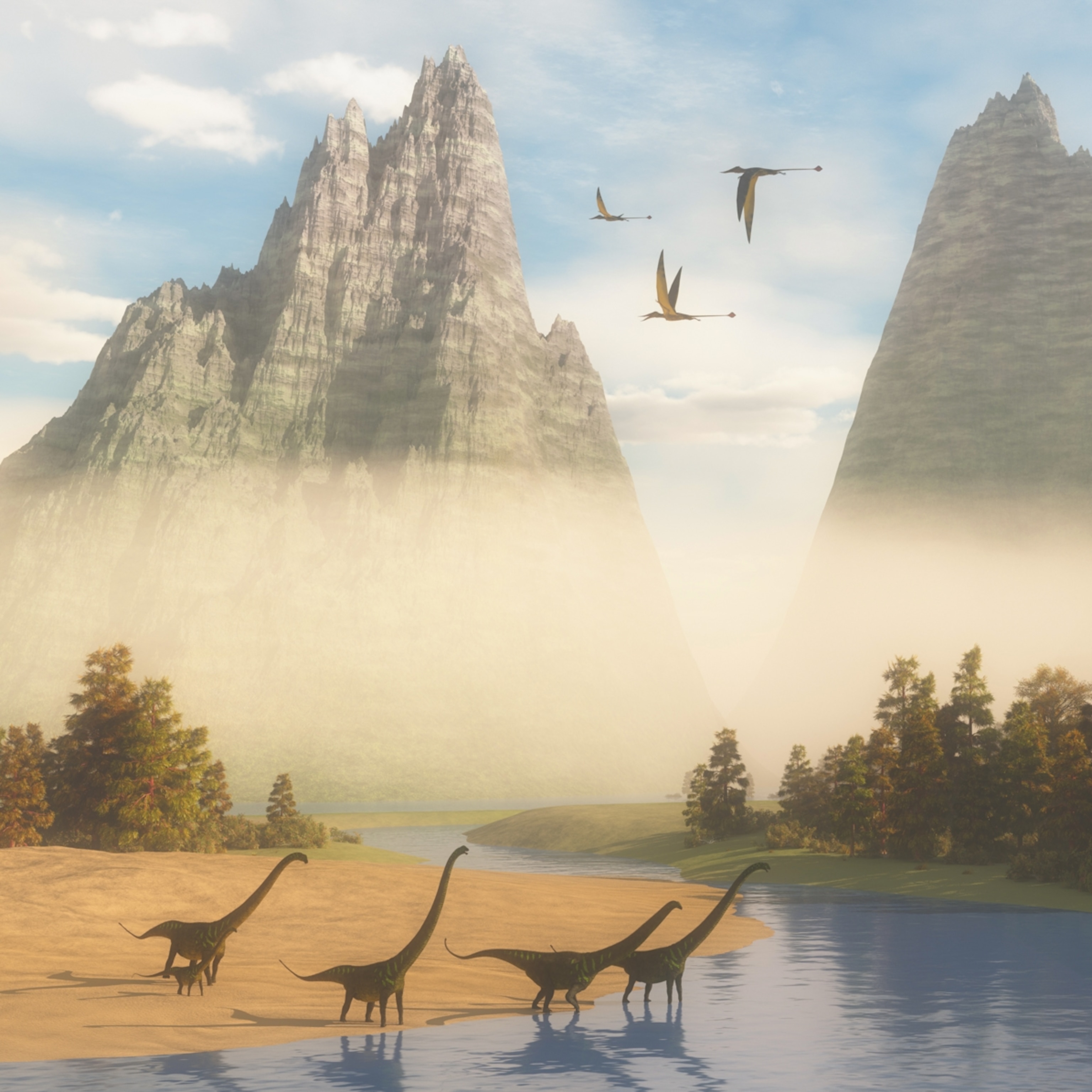
Pterosaurs—Lords of the Ancient Skies
Read a National Geographic magazine article about pterosaurs, the largest animals that ever flew, and get information, facts, and more about these prehistoric flying reptiles.
Three flying reptiles from Earth's distant past glide above the gray Pacific, far beyond the rollers breaking on the shore of Point Reyes, California. They flap their wings slowly for a few beats, gain some altitude, then turn toward the beach. One peels out of formation and dives into the water with a splash, sinking just as far as its shoulders to snatch a fish with its long snout. Then, with a few powerful wing strokes, the beast takes off, using its webbed feet to hop off the waves until it clears the water. As it draws near, the primeval pterosaur transforms into an ordinary brown pelican.
Keven Padian, a paleontologist at the University of California, Berkeley, stands on the beach gazing at the birds through binoculars. Watching coastal birds helps Padian envision the time when pterosaurs occupied the same ecological niche, plunging for fish like pelicans, soaring like gulls, and pecking at the sand like sandpipers.
"Pterosaurs were just the coolest things that were ever in the air," says Padian. "They were the first vertebrates to fly. They did it long before birds and bats. And it terms of size, they pushed the envelope as far as it could go for a flying animal."
Like their cousins the dinosaurs, pterosaurs stand out as one of evolution's great success stories. They first appeared during the Triassic period, 215 million years ago, and thrived for 150 million years before going extinct at the end of the Cretaceous period. Their endurance record is almost inconceivable compared with the span of humans, whose ancestors started walking upright less than four million years ago. Uncontested in the air, pterosaurs colonized all continents and evolved a vast array of shapes and sizes. Of more than 120 named species, the smallest pterosaur measured no bigger than a sparrow; the largest reached a wingspan of nearly 40 feet (12 meters), wider than an F-16 fighter.
Until recently most paleontologists would not have put pterosaurs in the same league as birds in terms of flying ability. Because pterosaurs were reptiles, generations of scientists imagined that these creatures must have been cold-blooded, like modern snakes and lizards, making them awkward aerialists at best.
In the past three decades, however, a surge of fossil discoveries around the globe has prompted researchers to reexamine their views. The emerging picture of pterosaurs reveals that they were unlike any modern reptile. From a fossil discovered in Kazakhstan, paleontologists suspect that pterosaurs had a hairlike covering, perhaps akin to fur. If so, this detail provides evidence of a high-revving, warm-blooded physiology that could sustain the kind of exertion needed to stay in the air. Judging from the skulls of other fossils, scientists reason that many pterosaurs were gifted air-borne predators, built to feed on the wing. They darted after insects, dive-bombed for fish, and soared hundreds of miles over open ocean on extended hunting expeditions.
"For about 150 years pterosaurs were regarded as typical slow-moving, cold-blooded reptiles. People had the idea that pterosaurs could glide, but they couldn't flap their wings," explains Alexander Kellner, a Brazilian paleontologist. "We thought they couldn't take off from the ground."
Pterosaurs first grabbed Kellner's attention when he was a child in Rio de Janeiro, where he became hooked on a television cartoon featuring one. His early fascination might have foundered, but when Kellner was a student, Brazilian scientists started to uncover a mother lode of pterosaur fossils in the northeastern part of the country, on the slopes of the Araripe Plateau. In the past 30 years Araripe has yielded remains of 19 new species, an unrivaled pace of discovery.
These pterosaurs soared over South America during the middle of the Cretaceous period, more than a hundred million years ago. At that time a large saltwater lagoon covered the Araripe area, and the African continent lay just over the horizon, separated by a young sliver of ocean that would later grow into the Atlantic.
Among the Araripe discoveries some of the strangest have been identified by Kellner and his mentor Diogenes Campos of the Brazilian Department of Mineral Production. At his office in Rio de Janeiro, Campos pulled out one of his favorite characters, a 110-million-year-old Araripe pterosaur that he and Kellner christened Anhanguera, or "old devil." It's an apt name—the fossilized skull could easily have flown out of a gothic ghost story.
Still partly entombed in rock, the glossy fossil looked leaden and cold. But as I ran my fingers over the 20-inch-long (50-centimeter-long) jawbone, tracing its curves and pits, I could imagine the Araripe pterosaurs sailing over the ancient lagoon. A solitary Anganguera takes flight, its 13-foot (4-meter) wingspan silhouetted against the sky. The pterosaur sweeps its large keen eyes over the water, pulls its wings inward to pick up speed, and swoops low. Dropping its mouth into the water, the hunter uses its beak to slice through the waves like a black skimmer bird. In a flash the pterosaur jerks its head up and veers skyward, gripping a wriggling fish in its teeth.
Along the shore diminutive pterosaurs called Tapejara wellnhoferi pluck nuts and fruit from scrubby trees with their toucan-like beaks. Above the whole tableau soars the most impressive Araripe species, a giant called Tupuxuara, with a 20-foot (6-meter) wingspan. This toothless pterosaur had a rounded four-foot-long (1.2-meter-long) crest protruding from its skull like an exaggerated Mohawk haircut.
Paleontologists can paint this vivid portrait of Araripe pterosaurs because their bones were exquisitely fossilized, intact and uncrushed, within the quiet sediments at the bottom of the lagoon. By comparison, the flattened pterosaurs from most other sites around the world look like prehistoric roadkill. The Araripe fossils have enabled researchers to get a better fix on what pterosaurs actually looked like and how their bones fit together. They can see, for example, how the upper arm bone, or humerus, produced the flapping motion that kept pterosaurs in the air. The bone looks something like a hatchet: a stout shaft topped by a flared-out blade where it joined the shoulder. The wide head must have provided a broad anchoring point for the powerful chest muscles pterosaurs needed to flap their wings.
The weight of these large muscles was offset by lightweight, eggshell-thin bones filled with air. Larger species had slender struts inside hollow wing bones, adding strength without many additional pounds. So even with wings almost as wide as a house Tupuxuara may have weighed no more than a child. "They were so light," Campos said, "it's possible that they only had to open their giant wings and the wind would pick them up."
Hollow bones gave pterosaurs an advantage during life but were a hindrance to their immortality. Pterosaur skeletons were so delicate that they survived as fossils only when their corpses came to rest in a protected environment. For that reason most pterosaur remains come from species that lived near the ocean—the soft seafloor ooze entombed their bodies for eternity.
Even with the new discoveries, the rarity of fossils leaves major gaps in knowledge about pterosaurs. No one knows how they evolved flight, why they vanished, or exactly what they looked like. Debate swirls around these reptiles like the air currents they once rode.
Controversy has surrounded pterosaurs since the first discovery of one at the end of the 18th century. At the Bavarian State Collection of Paleontology and Historical Geology in Munich, paleontologist Peter Wellnhofer pulled out a large drawer filled with fossils and pointed out a fragile skeleton, which was no bigger than my hand. "Here is the famous Pterodactylus antiquus," he said. Embedded in a slab of limestone 150 million years old, the creature lay with its mouth agape in a pose of prehistoric horror. It has a long toothy snout, a giraffe-like neck, and lanky legs, but its most unusual feature is its forelimbs. Next to three small fingers is a fourth that extends ten times the length of the other digits.
Cosimo Alessandro Collini, the first natural historian to study the fossil, was stumped when he described it in 1784. Seventeen years later the great French anatomist Georges Cuvier deduced that the animal was a flying reptile, whose fourth finger supported a wing. Although the wing surface had not fossilized, Cuvier surmised that a membrane of skin had attached to the forelimb in life.
He later named the fossil Pterodactylus, combining the Greek words for wing and finger. A few decades later the term pterosaur, or winged reptile, was coined to describe the growing list of similar fossils.
In 1873 a remarkable pterosaur specimen came to light that confirmed Cuvier's deduction. Unlike earlier fossils, this new find near the Bavarian town of Solnhofen contained delicate wing impressions, clear proof that extinct reptiles could fly.
Even with more than a thousand pterosaur specimens known today, such wing impressions remain rare. Normally only bones survive the fossilization process. Material as ephemeral as skin or hair disintegrates long before an animal turns to stone. But time was kind to the pterosaurs that died near Solnhofen because many were preserved in the sediments of a Jurassic lagoon.
Wellnhofer slid open another drawer and gingerly removed a gull-size pterosaur named Rhamphorhynchus, with a wing so beautifully preserved that I could see impressions left by delicate folds of its skin. Under the microscope the surface of the wing looked corrugated, almost like corduroy. This texture comes from fine fibers only two-thousandths of an inch thick that were inside the membrane. Paleontologists don’t know what the fibers were made of, but they suspect that they added strength to the wing, in much the same way the thin metal frame of an umbrella supports the fabric.
"This is a unique characteristic of pterosaurs," Wellnhofer said. "The fibers may have helped stiffen the wing membrane. They could also have kept the wing bent, cambering its surface."
Some 150 million years after Rhamphorhynchus flew, aeronautical engineers would use the same cambered-wing principle when building planes.
Rhamphorhynchus would have displayed its piloting skills while fishing for food over the Jurassic lagoons, Wellnhofer said, pointing out the spearklike snout on one specimen. "Look at the end of the lower jaw. It is very long and pointed. They skimmed above the water, with just the tip of the lower jaw plowing through the water. And if they met a fish, they could catch it with their long slender teeth like so," he said, clamping his hands together.
Pterosaurs could carry out these precise actions because they had a highly specialized brain. Their enlarged cerebellum, a characteristic more like the brain of birds than reptiles, provided the enhanced muscular coordination required for maneuvering on the wing. Such adaptations of brain and body must have taken untold millennia to transform a four-legged reptile into a full-fledged flier.
But the evolutionary path to the air remains in dispute. Most researchers conclude that pterosaurs descended from a small arboreal reptile that spent its life jumping between branches. Like the modern flying squirrel, this creature would have spread its limbs, using flaps of skin attached to its limbs and body to brake its fall. Over many generations the fourth finger on each forelimb grew longer, enlarging the skin surface and enabling the animal to glide farther.
The competing theory holds that pterosaurs evolved from bipedal reptiles that ran along the ground, perhaps spreading their arms for balance. Through gradual growth, the forelimbs would have evolved into wings.
All paleontologists admit, however, that the question of origins remains open, awaiting new fossil discoveries of early forms of pterosaurs. "It's very difficult to say how they evolved because the first pterosaurs we have are true, complete pterosaurs," said Fabio Dalla Vecchia, a researcher at the Paleontology Museum in Monfalcone, Italy. "Their fourth finger has already transformed into a wing."
The earliest known pterosaurs come from the mountains of northern Italy, where Dalla Vecchia has spent years prospecting for flying reptiles. These species have shorter wings than later forms, but there is evidence that they were over open water. I found proof of this prowess while examining the fossil of a Eudimorphodon, a 215-million-year-old pterosaur unearthed near Bergamo, Italy, in 1973. Under a microscope in the Civic Museum of Natural Science in Bergamo, several fish scales glistened in the abdominal region of the specimen—the remnants of this pterosaur's last meal.
Rupert Wild, a German paleontologist who discovered the scales, suggests that the pterosaur caught its prey much like brown pelicans do, dive-bombing under the water to grab its victims. "Eudimorphodon had a wrist that could bend 180 degrees backward," Wild said. "So they could fold their wings very tight to the body and then plunge into the water."
Until the discovery of Eudimorphodon, paleontologists thought that pterosaurs originated 200 million years ago, near the beginning of the Jurassic period. The find pushed the record back 15 million years, to the Triassic period.
When Eudimorphodon first took to the skies, it gazed down on a landscape completely alien to modern eyes. The continents were gathered together into one landmass called Pangaea that stretched nearly from Pole to Pole. Crocodile-like reptiles reigned as top carnivores, while dinosaurs were increasing in number.
The balance of power shifted as the Triassic closed. Extinctions dethroned the prevailing reptiles, and fleet, meat-eating dinosaurs took over. During this period pterosaurs went through their own transformations, diversifying into dozens of species that ruled the winds. A clue to their evolutionary success came from the Qaratai (Karatau) Mountains of Kazakhstan in the 1960s when zoologist A.G. Sharov discovered fossils of an unknown species with well-preserved hairlike fibers. He named the new pterosaur Sordes pilosus, or "hairy devil."
Sordes clearly set pterosaurs apart from the reptiles known today. Crocodiles and lizards don't need an insulating layer over their bodies because they are cold-blooded: Their body heat and activity rise and fall with the ambient temperature. But the fibers on Sordes suggest that pterosaurs needed to keep their body temperature elevated. It's one clue that they may have evolved an advanced, warm-blooded physiology similar to birds and mammals.
This discovery of a "hairy" coat meshes perfectly with the animal's image as active fliers, said David Unwin, a paleontologist at Humboldt University's Museum of Natural History in Berlin. Warm-bloodedness would have given pterosaurs the endurance to power their muscles for long periods of time.
"There is no way that pterosaurs could have managed sustained flapping flight unless they had an elevated metabolic rate, unless they could get oxygen into their cells and carbon dioxide out rapidly," he said. "They couldn't have flapped for more than a few minutes if they had been cold-blooded. They would have crashed to the ground."
Like all early pterosaurs, Sordes had a long reptilian tail. By the time of Sordes' last hurrah at the end of the Jurassic, 144 million years ago, short-tailed pterosaurs called pterodactyloids had arrived. Over the next 80 million years these new forms would flourish, diversifying into an arkful of different species with unusual specializations for feeding and flight.
Some pterodactyloids evolved jaws lined with hundreds of needle-thin teeth, perfect tools for filtering tiny plants and animals from shallow lakes. Others such as the North American Pteranodon had no teeth. Its smooth jaws probably had a covering of hornlike material, similar to the beak of a bird.
What Pteranodon lacked in teeth, it more than compensated for with its imposing skull. One species had a head nearly six feet (1.8 meters) long, balanced on its neck like the top bar of the letter "T." The rear half of the skull consisted of a bony crest that grew straight backward. Pteranodon and its crest have perplexed researchers since the 1870s, when its bones turned up in the chalk layers of western Kansas. Some viewed the crest as a forward rudder, enabling the almost tailless pterosaur to steer while flying. Other scientists proposed that Pteranodon's crest served as an air brake: To slow down for landing, the animal would simply turn its head broadside to the wind.
Chris Bennett, a paleontologist, dismissed both theories while showing me a Pteranodon fossil in the museum basement at the University of Kansas. The animal looked comically out of proportion, with a stretched-out skull that dwarfed its torso and hind limbs. To explain its huge head, Bennett invoked the same reason that teenage boys swagger: To establish rank among the guys and to impress the girls.
While studying Pteranodon fossils, Bennett concluded that the adult specimens fell into two categories. One group had big crests and small pelvises. The other had small crests and big pelvises. The latter were females, Bennett reasoned, because the large pelvises helped in laying eggs. The big crests belonged to the males. "My explanation for this is that the crest was a display device like the horns and antlers of mammals or the fancy feathers of birds," Bennett said. "I believe that Pteranodon was polygynous, that one male would mate with many females and only the dominant males would be mating with the females."
Although the mating rituals of Pteranodon remain speculative, one aspect of its behavior is clear from the fossil record. The remains of Pteranodon are found in rocks that lay more than a hundred miles (160 kilometers) out to sea in the Cretaceous period. This fish catcher, which had a wingspan of up to 24 feet (7.3 meters), must have regularly soared vast distances over the waves, its wings outspread to catch the steady ocean winds.
Aeronautical engineers once imagined that Pteranodon pushed the boundaries of animal flight. They calculated that a creature any larger would have been too heavy to lift itself into the air. The beast that broke those rules glares down at visitors milling about the Museum of Flying in Santa Monica, California. It is a life-size model of Quetzalcoatlus northropi, with a yellow beak the size of a man and a wingspan wider than many of the planes exhibited nearby. Paleontologists estimate that this pterosaur and a related form had wingspans of at least 36 feet (11 meters), making them the largest flying animals known. Birds don't come close. The wingspan of the largest living bird, the wandering albatross, measures only 11 feet (3.3 meters).
Quetzalcoatlus represents the pinnacle of pterosaur design, capping a trend toward larger sizes that had started at the beginning of the Cretaceous, 144 million years ago. Unlike smaller pterosaurs, they could exploit natural up currents to stay aloft without having to flap continuously, said Paul MacCready, an aeronautical engineer. "Most animals don’t get anything free from nature," he added "but as some pterosaurs and birds got larger, they stumbled upon evolutionary benefits from soaring, making use of a free energy source. With their hollow bones, these pterosaurs had a super lightweight construction ideal for soaring."
As we circled underneath the Quetzalcoatlus in Santa Monica, MacCready pointed out its similarity to sailplanes, the most efficient of airplanes. Both have long slender wings designed to fly with minimum power. During flight, sailplane pilots routinely search for places where heat radiates from sunbaked earth, creating rising air currents called thermals. Undoubtedly Quetzalcoatlus would have exploited thermals as well, lazily circling over the river deltas that once covered the Big Bend region of Texas.
The triumphant reign of pterosaurs ended with this giant flier. At the end of the Cretaceous period 65 million years ago, a meteorite or comet slammed into Earth. That calamity—and other events—wiped out roughly three-quarters of all animal species, including all remaining pterosaurs and dinosaurs. But the number of pterosaur species appears to have dwindled for millions of years before the cataclysm, suggesting that something else contributed to their fate.
It could be that the evolutionary achievements of pterosaurs ultimately led to their downfall. Quetzalcoatlus and other late pterosaurs had evolved gigantic wings ideal for soaring, but the specialization came at a price. Longer wings make an animal less maneuverable and don't work as well in the strong winds that may have been typical in the late Cretaceous, said Wann Langston, Jr., a paleontologist at the University of Texas and an expert on Quetzalcoatlus.
"Pterosaurs were very delicate creatures. They were as light as butterflies, and if there were turbulent winds in the area, they would have had to remain on the ground," he said. "This may have been a factor in their extinction because the world climate was deteriorating. And if climate deteriorates, the bigger the pterosaur, the bigger the disadvantage."
Whatever the cause of their demise, pterosaurs enjoyed unparalleled success. They trailblazed a path into sun-drenched skies before any other vertebrate. For 150 million years they sailed the winds on the strength of a fragile finger. What a glorious ride they had.








